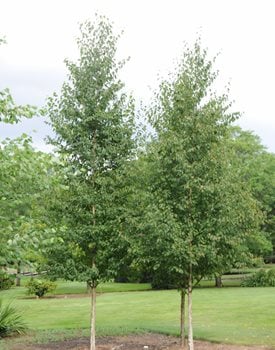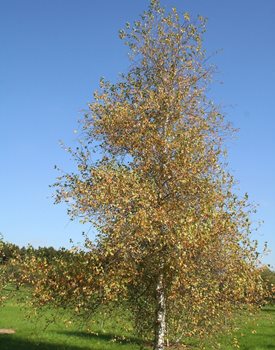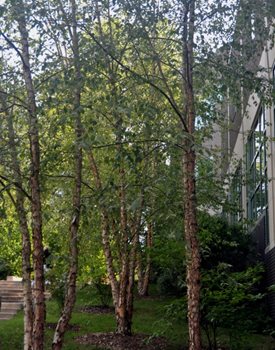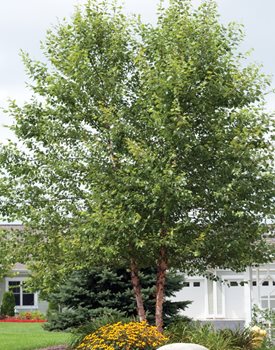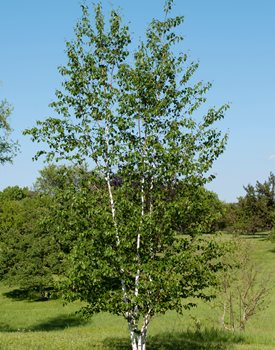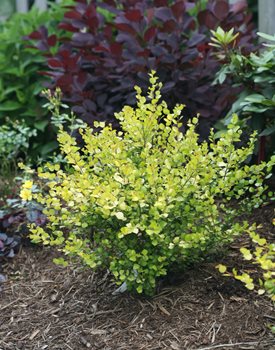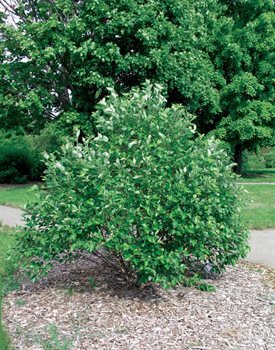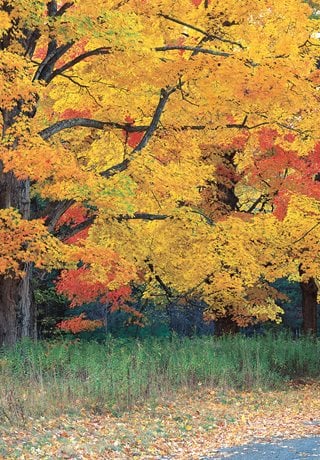Birch Tree Basics
How to plant, care for, and use birch trees in the gardenIt’s rare to find a deciduous tree that makes a big impact in the winter garden, but the birch is an exception. With papery scrolls of bark in colors ranging from snow white to cinnamon brown, the birch takes center stage in the garden after the leaves fall and other plants go dormant. But the bark is just one of the birch tree’s many attributes. Learn about the qualities that make it a beautiful addition to the landscape no matter what the season.
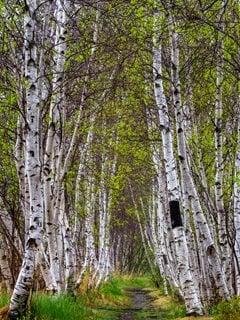
Birches grow on either side of this path in Acadia National Park. Photo by: J.K. Putnam / Alamy Stock Photo.
Birch trees (Betula) are usually denizens of colder regions of the northern hemisphere because they don’t fare well in hot, dry climates. There are about 18 species native to North America, but the ones listed here are among the most common and provide the greatest ornamental value.
- Betula papyrifera (paper, white or canoe birch)
Zones: 2-6 | Mature height: 50 to 70 feet
This iconic tree of the northeastern U.S. is the one you’re likely to think of when a birch comes to mind. Its pristine white bark and golden yellow fall color have made it the most widely grown birch in North America. It is often multi-trunked, which only amplifies the beauty of the distinctive bark. Becomes more susceptible to bronze birch borer when planted out of it's range.
Buy paper birch seedlings from the Arbor Day Foundation. - Betula lenta (sweet, black, or cherry birch)
Zones: 3-7 | Mature height: 40 to 50 feet
Smooth reddish-brown bark accented by rows of white lenticels make this birch a handsome alternative to white-barked species. Native to the eastern U.S., it is also a bit more heat tolerant than other varieties (with the exception of the river birch) and resistant to the bronze birch borer. As the tree matures, the bark becomes almost black, like that of a cherry tree, and peels away in broad plates. One of the best birches for fall color, with large oval leaves that turn a rich golden yellow. - Betula nigra (river birch)
Zones: 4-9 | Mature height: 40 to 70 feet
The only birch whose native range includes the southeastern U.S., this birch is unfazed by heat and humidity. Particularly attractive in the winter months, it has exfoliating bark in shades ranging from light taupe to cinnamon brown, with some cultivars displaying multiple layers of color. The small, triangular double-toothed leaves turn a buttery yellow in autumn. Tolerant of wet soil, river birch is a useful tree for rain gardens, low areas, and the banks of rivers and streams.
Buy river birch seedlings from the Arbor Day Foundation. - Betula populifolia (gray or poplar birch)
Zones: 3-6 | Mature height: 20 to 40 feet
As the name implies, the bark of this species is an ashier white than that of the more popular B. papyrifera. However, this tree is a good choice for poor soils, tolerating acidic, dry and wet conditions, and it thrives in cool northern climates. Most notable are the glossy dark green leaves, which are long, triangular, and sharply pointed. - Betula alleghaniensis (yellow birch)
Zones: 3-7 | Mature height: 60 to 75 feet
This species is not widely grown in residential gardens because of its size and darker bark color, yet it’s truly a native treasure, says Michael Dirr, in his book Dirr's Encyclopedia of Trees & Shrubs. “In fall, the brilliant golden yellow foliage compensates a thousandfold. The leaves are also highly resistant to leafminer, a severe problem for many of the white-barked species,” he says. The yellow birch’s rough-textured bark has its own unique beauty, with a soft metallic sheen similar to polished bronze.
Non-native birches include:
- Betula pendula (European white birch)
- Betula utilis var. jacquemontii (Himalayan birch)
- Betula platyphylla (Japanese white birch)
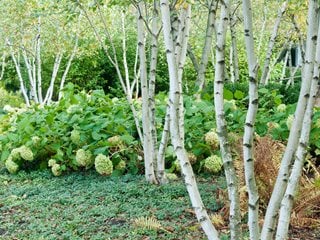
In this garden, ‘Whitespire’ birches were planted in a scattered fashion to appear as if they grew here naturally. Photo by: Garden World Images Ltd / Alamy Stock Photo.
When to plant:
The best time to plant birch trees is in the spring or fall, when the soil is moist and temperatures are cool. If planting in the fall, allow at least four to six weeks before the ground freezes to give the roots enough time to become established (see What to Plant in Your Fall Garden).
Where to plant:
Because birch are shallow-rooted, they prefer a location where the soil remains cool and moist while exposing the canopy to ample sunlight (about 6 hours daily). The ideal spot is the north or east side of a building, where the tree will receive full sun in the morning and some shade during the afternoon.
Soil:
Birch can thrive in a wide range of soil types, really only objecting to extremely wet or dry conditions, says Paul Bartlett of Stone Lane Gardens, a specialist in birch and alder trees. Some birch will even grow successfully in wet ground as long as it is not waterlogged. Slightly acidic soils (with a pH between 5.0 and 6.5) are ideal, but preferences vary with the species, with river birch favoring a pH below 6.5 while yellow birch is tolerant of alkaline conditions. Here are some tips for testing the pH of your soil: Garden Soil 101.
Planting tips:
You can plant birch trees in groups or as single specimens, depending on the space available and your design intent. “There are no strict rules about planting distances, and if space is limited, three trees planted in the same hole can create an effective mini copse,” says Bartlett. If you prefer a multi-trunked tree but can’t find one at a local nursery, he suggests creating the same effect by planting three trees in one hole with their roots almost touching. As the group matures, the trunks will eventually touch at the base.
Watering:
Most birch are sensitive to drought and grow best in conditions where their shallow root system will be kept cool and moist, especially during the heat of the summer. Keep the soil moist to the depth of the roots, particularly during the first couple of years after planting, by soaking it thoroughly with a hose. Covering the root zone with a 2- to 3-inch layer of mulch will also help to retain moisture.
Fertilizing:
Birch trees planted in high-pH soils may need supplemental iron to prevent yellowing of the leaves (chlorosis). Applying a low-nitrogen, slow-release fertilizer with iron will help boost the acidity of the soil and improve nutrient uptake.
Diseases and pests:
The bronze birch borer is the most threatening pest of ornamental birch, especially white-barked varieties and trees under stress. Early warning signs of damage are a yellowing and thinning of foliage at the upper crown of the tree and D-shaped holes in the trunk where the borer larvae have made entry. Another common pest, the birch leafminer, feeds inside the leaves of birch trees and can also cause browning of the foliage. See this advice from the Morton Arboretum for preventing, identifying, and treating bronze birch borer and leafminer attack.
Pruning:
The best time for pruning birch is in late fall or winter when the tree is still dormant. Birches will “bleed,” or lose sap, if you prune them in early spring before the leaves emerge. Also avoid pruning birch during the summer when birch borers are active, since they are attracted to fresh wounds in the bark.
Cleaning:
The only drawback to white bark is that it may begin to look gray and dingy after time. The solution? Simply give it a good scrubdown with water and mild dish soap. This is a great beauty treatment for older birch trees because it removes the buildup of dirt, lichen, and moss without damaging the bark. See these birch cleaning tips from the Chicago Botanic Garden.
USING BIRCHES IN THE GARDEN
- Because the trunk is the most eye-catching feature of most birch trees, give it the attention it deserves with the right backdrop. Dark evergreens planted behind the trunks will show off the beauty of white forms dramatically, says Bartlett. Similarly, keep foreground plantings low so the full impact of the trunk can be seen from the ground up.
- Planted as a single specimen, a birch creates an exceptional focal point in the garden or even in the center of a lawn. When given enough room, it will naturally form a broader, more rounded shape. And because the small leaves and delicate branching structure produce only light shade, it rarely inhibits the growth of underplantings.
- A lighted birch can make a dramatic statement at night. The white bark glows brilliantly when lit from below. Make sure the fixture is hidden from sight and include some silver or white plants at the base of the tree (see Creating Night Garden Drama).
- Birch look stunning as borders for allées and walkways, especially when the trunks lean toward each other to create a gentle arch (see 10 Great Design Ideas for Trees).
- Attractive underplantings for birch trees that grow well in slightly acidic soils and light shade include Vinca minor, blue wood sedge (Carex flaccosperma), dicentra, viola, hosta, rhododendron, lady fern (Athyrium filix-femina), and ajuga.
BIRCH TREE PICTURES
Check out some of these popular birch cultivars:
Not pictured:
CITY SLICKER
(Betula nigra ‘Whit XXV’)
Notable for its lustrous dark-green foliage and uncharacteristically white bark, which rivals that of B. papyrifera. Also drought tolerant, borer resistant, and more adaptable to higher-pH soils. In fall, the foliage takes on a lovely golden hue.
Height: 35 feet
Spread: 25 feet
Related reading:
Bark Adds Color, Texture & Pattern to the Garden
Get Colorful Fall Foliage
